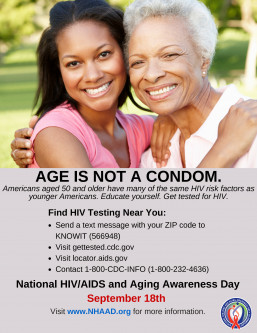Tuesday, September 18, marks National HIV/AIDS and Aging Awareness Day (NHAAD) 2018. Launched a decade ago by The AIDS Institute, the campaign is a chance to raise awareness and highlight the numerous HIV-related issues facing people 50 years old and over.
First, here’s an NHAAD infographic:

Downloadable graphic for NHAAD 2018Courtesy of The AIDS Institute
And below are some statistics from the Centers for Disease Control and Prevention:
- Thanks to better treatments, people with HIV are living longer. People age 50 and over account for an estimated 45 percent of Americans living with diagnosed HIV.
- People age 50 and older have the same HIV risk factors as younger people, but may be less aware of their HIV risk factors.
- Older Americans are more likely to receive a diagnosis of HIV later in the course of their disease.
- People age 50 and over accounted for 17 percent (6,725) of the 39,513 HIV diagnoses in 2015 in the United States. People age 50 to 54 accounted for 45 percent (3,010) of the diagnoses among people age 50 and over.
Another way that older people are affected by HIV is reflected in the current POZ cover story, “Grand Parents: Raising the children of parents lost to AIDS.”

People aging with HIV often face isolation. POZ recently profiled two new groups helping this community via workshops and social outings. To learn more about the Terry Brenneis Hub for Long-Term Survivors at New York’s Gay Men’s Health Crisis and The Metropolitan Community Church of the Palm Beaches HIV Long-Term Survivors Network in Florida, read the article “A Message for HIV Long-Term Survivors: Stay in Touch.”
Visit NHAAD.org for graphics you can download and share. You’ll also find resources and ways you can connect and learn more about HIV and aging.
And be sure to take this month’s POZ survey “Getting Older” about aging with HIV.

Downloadable graphic for NHAAD 2018Courtesy of The AIDS Institute







Comments
Comments